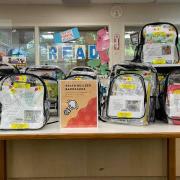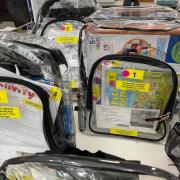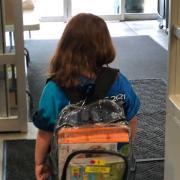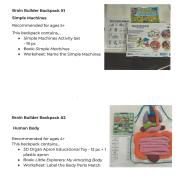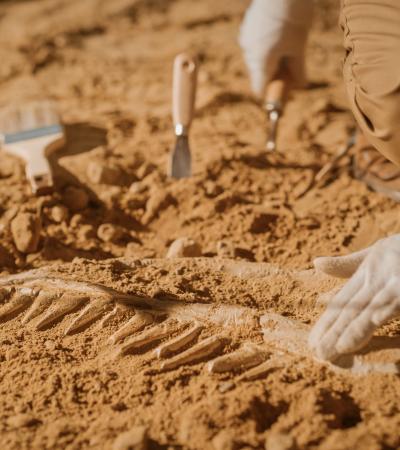The Oceanside Library Brain Builder Backpacks are a circulable collection filled with material to facilitate at-home learning of various STEAM subjects for children.
Each backpack covers a different topic ranging from music to the human body to engineering and contains a book, a worksheet, and a hands-on activity to act as a fun and engaging at-home continuation of programs offered at the library. Backpacks vary in subject and age group (generally for ages 3-12). Patrons can check out the backpacks for 2 weeks at a time.
Advanced Planning
Planning to launch the Brain Builder Backpacks lasted 2 months from conception to implementation through the work of the head of youth services and children’s librarians.
To pick which topics each of the backpacks would explore, the overarching STEAM category was narrowed down into more specific ideas including birdwatching, engineering, insects, telling time, the human body, and more. Although the books were primarily those already in the library’s collection, additional copies were purchased for the backpacks along with the hands-on activities. Each backpack was filled with a book, an activity, and a worksheet before they were set on the shelves to be taken out.
Some of the hands-on activities include a magnifying glass to observe bugs and nature from the insects backpack, a set for building simple machines and technology in the engineering backpack, and a suit of the internal organs that children can actually wear and interact with in the backpack on the human body. Like books for circulation, there is no additional base setup because the backpacks themselves don’t change as they are circulated. They were entered into the computer as items for check-out before the launch of the program and now function the same way.
Marketing
We share posts on the library’s various social media pages including pictures of the backpacks and patrons checking them out of the library .
We display some of the clear backpacks in front of the children’s information desk so kids and parents can see the materials and an itemized list of components .
We have also planned a future interview with the local Herald newspaper to talk about the backpacks.
Budgeting
Each backpack cost approximately $30. This included the cost of the clear backpacks, new books, and crafts for each bag. They are all one-time purchases meant for re-circulation.
The only possible additional cost would be replacing a damaged book or missing piece of a hands-on activity.
Day-of-event Activity
As the backpacks are intended for circulation and not one-time use at a specified program time, setup remains essentially constant. The backpacks have their own space on the shelves of the children’s room for browsing and borrowing.
When they are returned, they are checked for any missing parts of the hands-on activity, sanitized, and re-shelved.
Program Execution
The program has been active for a month and so far has met our goals. Turnaround for the backpacks is very rapid with individual backpacks often only remaining on the shelf for a few hours or a day after they are returned.
We have heard positive feedback from parents, who sometimes now take out multiple backpacks for multiple children, and from other local librarians who have expressed interest in the concept. The popularity of the backpacks has inspired the planning of a second set of 10 topics to be added to the collection at a later date.
Advice
Base the concepts of your backpacks on what there is a demand for in your community. Past STEAM programs for children at our library have been met with much enthusiasm, and parents have often asked for ways to continue this type of engaging learning with their children at home.
The concepts of a hands-on activity, a book, and a worksheet in the backpack can be adapted to fit the needs and interests of your community.

